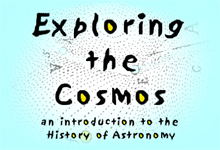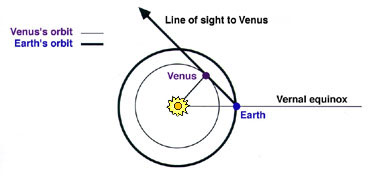

Department of History
University of California, Irvine
Instructor: Dr. Barbara J. Becker
![]()
The Relative Distances of Mars, Venus, and Mercury from Earth
![]()
DETERMINING THE RELATIVE DISTANCE TO
AN OUTER PLANET:
|
|
When Copernicus put Earth into motion around the Sun, he made us all astronomical surveyors and gave us a long baseline from which to triangulate the relative distances of the planets. He reasoned that an earthbound observer could determine the relative distance to an outer planet -- like Mars -- by (1) observing and recording its apparent location with respect to the background stars on one occasion, and then (2) sighting the planet a second time when it had completed one trip around the Sun.
You can use Copernicus's method and recent information about the position of Mars as seen against the background stars to determine its relative distance from the Sun. To simplify this task, first sight Mars on the date of its opposition. [When an outer planet is at opposition, it is exactly opposite the Sun in Earth's sky. That means it will rise at sunset, be located directly overhead at midnight, and set at sunrise.]Because of this unique alignment, you can easily draw in the line of sight to Mars whenever it is in opposition as shown in the following diagram:
Figure 1. Mars at opposition. There's no way to know exactly where Mars is located along this line of sight. To pinpoint Mars's true position, you will need to sight it again, this time from a different point of view. But Mars is in motion -- even Ptolemaic astronomers would agree with that! You can't conduct a successful triangulation if the distant object is in a different place each time you sight it! Fortunately, Mars returns to this same heliocentric location one martian year, or 687 days, later.
Figure 2. Mars, one martian year later. Where is the Earth located at this time? In 687 days, Earth will have circled the Sun once and be well on its way toward completing a second orbit.
Figure 3. Earth, one martian year later. You won't see Mars directly overhead at midnight. To sight Mars, you'll have to look to the eastern horizon near dawn. The angular distance of a planet from the Sun is called its elongation. Mars will be located somewhere along your new line of sight. But where?
Figure 4. Sighting Mars. Like a surveyor who has sighted a distant object from two ends of a long baseline, you can now determine the location of Mars by noting where the two lines of sight to Mars intersect. Using geometry, you can now determine the distance of Mars from the Sun relative to the Earth-Sun distance (one astronomical unit, or 1 AU). In fact, you can easily approximate Mars's distance from a simple scale drawing:
Figure 6. Determining Mars's relative distance to the Sun.
Lucky for you, since 1980 I've been keeping a record of the positions of Mars and Earth when Mars is (1) in opposition and (2) 687 days after opposition. This record can be found in Table I.
|
|
TABLE I. Positions of Earth and Mars (1980-2003) |
|
|
|
|
|
|
|
|
|
|
|
|
|
|
|
|
|
|
|
|
|
|
|
|
|
|
|
|
|
|
|
|
|
|
|
|
|
|
|
|
|
|
|
|
|
|
|
|
|
|
|
|
|
|
|
|
|
|
|
|
|
|
|
|
|
|
|
|
|
|
|
|
|
|
|
|
|
|
|
|
|
|
|
|
|
|
|
|
|
|
|
|
Click here to find a printable worksheet like the one shown below.
Sample worksheet. On the worksheet, the solid line circle depicts Earth's orbit. The marks surrounding the circle represent divisions of 5° to locate Earth's position in its orbit. The dot in the center represents the sun. The line which intersects the circle at 0° represents the vernal equinox.
Copernicus believed the orbits of all the planets were circular. For him, one set of measurements was sufficient to determine the dimensions of Mars's orbit. Johannes Kepler had access to several sets of these measurements, thanks to the meticulous record-keeping of Danish astronomer Tycho Brahe. Using these data, Kepler discovered that Mars's orbit was not circular. Use the data for other oppositions of Mars to determine its position in other years. Describe the orbit of Mars that you have plotted. How does Mars's distance from the Sun vary? When do you think Mars moves fastest in its orbit? When is it closest to Earth? Look up Mars's distance from the Sun. How do your values compare?
|
METHOD FOR DETERMINING THE
RELATIVE DISTANCE TO THE INNER PLANETS:
|
|
Ancient observers knew that Mercury and Venus never strayed very far from the Sun.
Figure 7. As seen from Earth, Venus never strays far from the Sun on the sky. But these early astronomers were hard pressed to explain why this happened. No obvious links connected the motions of the Sun, Moon, and planets. Some speculated that Mercury and Venus might actually travel around the Sun while the Sun orbited the Earth. Others suggested that Mercury and Venus were somehow tethered to the Sun and thus followed along as it moved. Some astronomers placed Venus closer to the Sun, while others reasoned that rank belonged to Mercury. There was no conclusive evidence to guide opinion on these matters.
Nicholas Copernicus (1473-1543) tried a completely different arrangement. He placed the Earth in motion around the Sun at a distance farther than both Mercury and Venus. When either of these planets reached its greatest angular separation from the Sun -- its greatest elongation -- Copernicus reasoned (based on simple geometric principles) that an earthbound observer's line of sight was simply a tangent to that planet's orbital path. Knowing this, he was able to determine the planet's relative distance from the Sun. Using the same worksheet on which you located the orbital distance of Mars:

Figure 8.

Figure 9.

Figure 10.

Figure 11. Repeat this procedure to find the orbital distance of Mercury in astronomical units.
|
| Go to: | ||||||||||||||||||||||||||||||||
|
||||||||||||||||||||||||||||||||
|